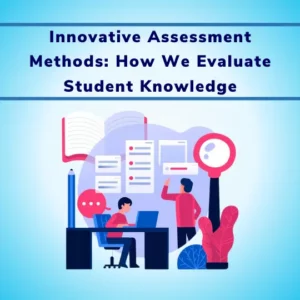Article Contents
Introduction
In the age of information, data has become as valuable as oil, especially in the education sector. As institutions seek to enhance their educational processes and outcomes, leveraging data smartly holds the key.
This article delves into how educational institutions can use organizational data effectively to improve every facet of education.
The Role of Data in Education
Overview of Data Science in Education
Data science in education can transform how institutions operate and educate. By analyzing trends and statistics, educators and administrators can gain invaluable insights into their operations, helping to make informed decisions that boost efficiency and educational quality.
Current Trends and Predictive Analytics
Predictive analytics enables institutions to foresee challenges and opportunities within the education landscape. Whether it’s predicting student enrollment trends or identifying the potential for dropout, data analytics provides a way to proactively address issues before they impact performance.
Capturing Data in Education
Data Collection Methods
Collecting data in an educational setting involves multiple stakeholders and systems. From digital admission forms to learning management systems (LMS), each touchpoint is an opportunity to gather valuable data.
Ethical Considerations and Privacy
As data collection increases, so do concerns about privacy and ethics. Institutions must navigate these waters carefully, ensuring data is collected and used in compliance with legal standards and ethical expectations.
Analyzing Admission Data
Admission data is a treasure trove of information that encompasses a wide range of details about candidates. This data typically includes personal information such as the candidate’s name, age, and contact details, as well as more specific data like state of origin, address, parental information, and socioeconomic status.
By maintaining and analyzing both current and historical admission data, educational institutions can unlock several strategic benefits that enhance their operational effectiveness and strategic marketing.
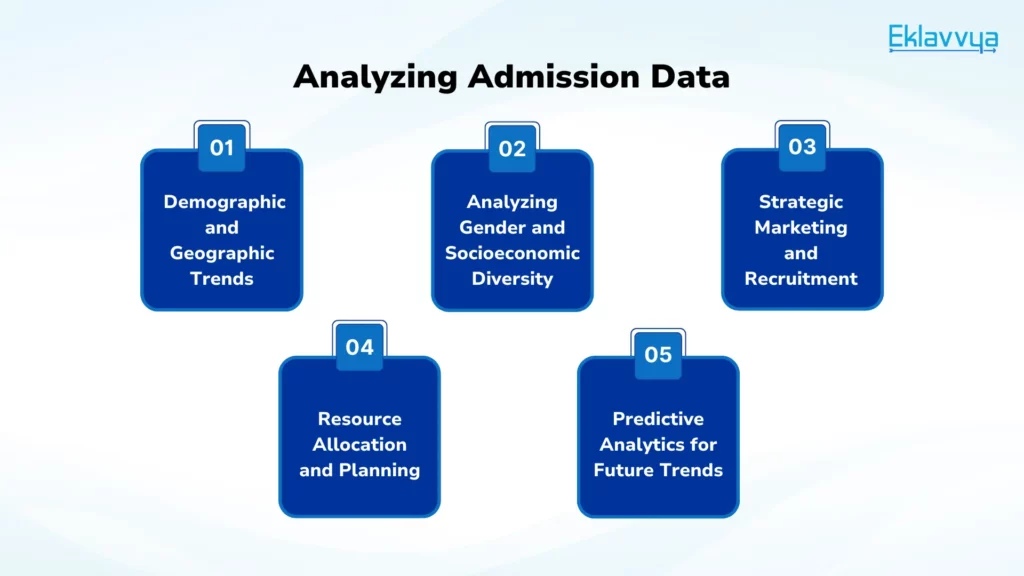
Understanding Demographic and Geographic Trends
One of the primary advantages of analyzing admission data is the ability to observe and understand demographic and geographic trends. For instance, institutions can track which regions or states yield the highest number of applications, identifying key areas where their institution appears to be popular.
This can inform targeted marketing campaigns or outreach programs, focusing resources on areas with high potential for student recruitment.
Analyzing Gender and Socioeconomic Diversity
Admission data also provides insights into the gender and socioeconomic makeup of applicant pools over time. Institutions can use this data to assess their performance in terms of diversity and inclusivity. By understanding trends in the male-female ratio or the socioeconomic backgrounds of applicants, schools can tailor their recruitment strategies to encourage a more diverse student body.
This might involve creating scholarship programs aimed at underrepresented groups or partnering with schools in lower-income areas to improve access to higher education.
Strategic Marketing and Recruitment
The insights gained from admissions data analysis are invaluable for refining marketing strategies. For example, if data shows a high number of applicants from specific areas or demographics, institutions might increase marketing efforts in those areas or tailor their messaging to appeal to those groups.
Conversely, areas with low application rates might indicate a need for increased brand awareness or targeted engagement activities.
Resource Allocation and Planning
Beyond marketing, the analysis of admission data can significantly impact resource allocation and planning. Understanding which programs attract more students can help institutions decide where to invest in terms of faculty, facilities, and course development.
This data-driven approach ensures that resources are optimized for the greatest impact, enhancing the institution’s ability to attract and retain students.
Predictive Analytics for Future Trends
By maintaining historical admission data, institutions can employ predictive analytics to forecast future trends. This can include predicting application numbers for upcoming cycles, anticipating shifts in demographic trends, or identifying emerging areas of student interest.
Such predictions allow institutions to be proactive rather than reactive, positioning them to better meet the needs of future students.
Automating Academic Document Verification
The verification of academic documents such as certificates, mark sheets, and other credential proofs is a crucial step during the admission process in educational institutions. Manual verification of these documents is not only time-consuming but also prone to human error, making automation a highly attractive solution.
Using Automation Tools like DocuExprt
Platforms like DocuExprt offer sophisticated services that automate the verification of academic documents. These tools use advanced technologies such as optical character recognition (OCR) and machine learning to quickly and accurately authenticate the documents submitted by prospective students. This helps in confirming the integrity and credentials of applicants efficiently.
Benefits of Automated Verification
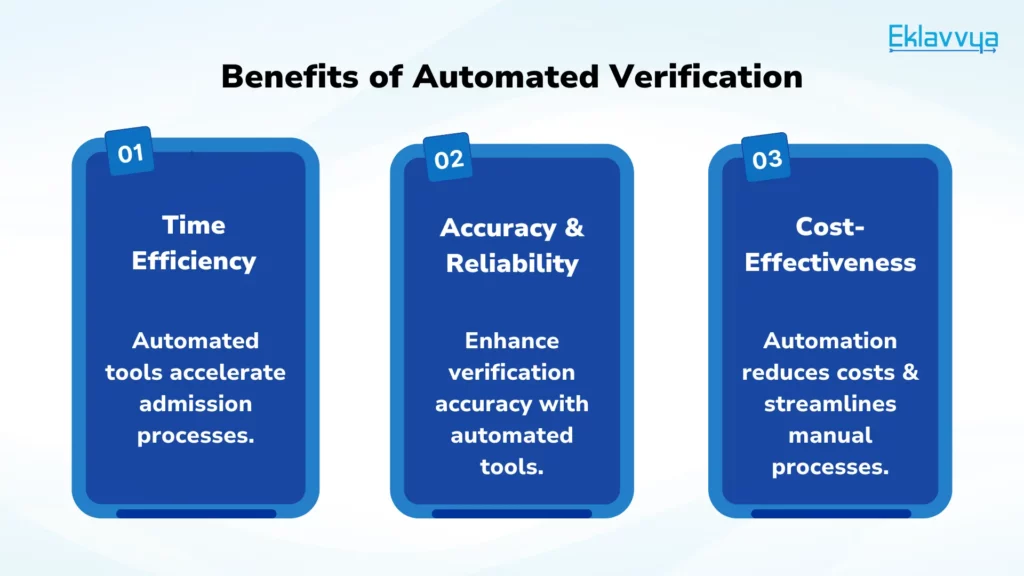
Time Efficiency: Automated tools can process large volumes of documents much faster than human staff. This speed significantly reduces the lead time from application to decision, enabling institutions to accelerate their admission processes.
Accuracy and Reliability: Automation reduces the risk of human error. Tools designed for document verification are programmed to detect inconsistencies and forgery more effectively than manual checks, thus ensuring higher accuracy in the verification process.
Cost-Effectiveness: While the initial setup for automation might require some investment, over time, these tools can reduce labour costs and administrative burdens associated with manual verification, making the process more cost-effective.
Data Extraction and Analysis
Beyond just verification, automated tools can extract key data from documents, such as student grades, qualifications, and other relevant information. This data is invaluable as it can be integrated into the institution’s management systems and used for various analytical purposes.
Profile Analysis: By analyzing the extracted data, institutions can gain insights into the profiles of their applicants. This includes academic performance, geographic distribution, and demographic information, which can inform targeted recruitment strategies.
Trend Identification: Over time, the aggregated data can reveal trends related to applicant qualifications and their success rates at the institution. This can guide curriculum adjustments, resource allocation, and strategic planning.
Predictive Modeling: With sufficient data, institutions can develop models to predict future applicant behaviours and outcomes. This can include predicting student success in certain programs based on their prior academic performance and aiding in personalized education plans.
Maintaining Data for Decision Making
The information extracted and verified through these automated tools can be systematically stored and maintained in an institution’s databases. This data reservoir becomes a critical asset for strategic decision-making, helping to shape recruitment strategies, academic programs, and institutional policies that align with student needs and market demands.
Automated verification systems ensure that all documents are checked against compliance standards and the results are easily accessible for audits and reporting, thus maintaining institutional credibility and integrity.
Technologies Used in Certificate Verification
Blockchain technology, for instance, provides a decentralized and tamper-proof method for certificate verification, ensuring the integrity of academic credentials.

Automating Question Paper Generation with AI
The process of generating question papers for exams such as semester assessments, annual end-term exams, or chapter-wise tests is crucial for evaluating the academic progress of students. The aim is to test students’ problem-solving abilities rather than just their capacity to memorize content.
Leveraging technology to automate this process can significantly improve the quality and relevance of examinations.
Integrating Technology in Exam Design
Customizable Inputs for Exam Creation: Modern automated systems allow educators to input specific parameters that define the scope and structure of an exam. This includes selecting difficulty levels, specifying chapter topics or a hierarchy of topics, and choosing the types of questions (e.g., multiple choice, essay, practical problems).
By providing these inputs, teachers can ensure that the exams are aligned with the syllabus and are appropriate for the learning objectives.
Use of Advanced AI Algorithms: AI algorithms can be employed to generate unique and diverse questions that challenge students’ conceptual understanding. These algorithms analyze existing question pools and curricular content to create questions that are not only relevant but also varied in form and complexity. This helps in minimizing the repetitiveness and bias that often come with manually created exams.
Maintaining Historical Data and Analysis
Archival of Question Papers: Automated systems can store every generated question paper along with its parameters and usage history. This archival is crucial for maintaining a record of assessment methods and aiding in future exam preparation and audits.
Performance Correlation: By comparing historical question papers with the actual performance of students, educational institutions can draw insights into how certain types of questions or difficulty levels affect student outcomes. This data can be critical in understanding the effectiveness of different teaching methods and exam formats.
Analyzing Batch and Evaluator Performance: The data collected from automated question paper systems can also be used to analyze overall batch performance over time. Furthermore, it can provide feedback on the performance of teachers or evaluators, indicating areas where teaching methods or materials might need improvement.
Benefits of Question Paper Automation
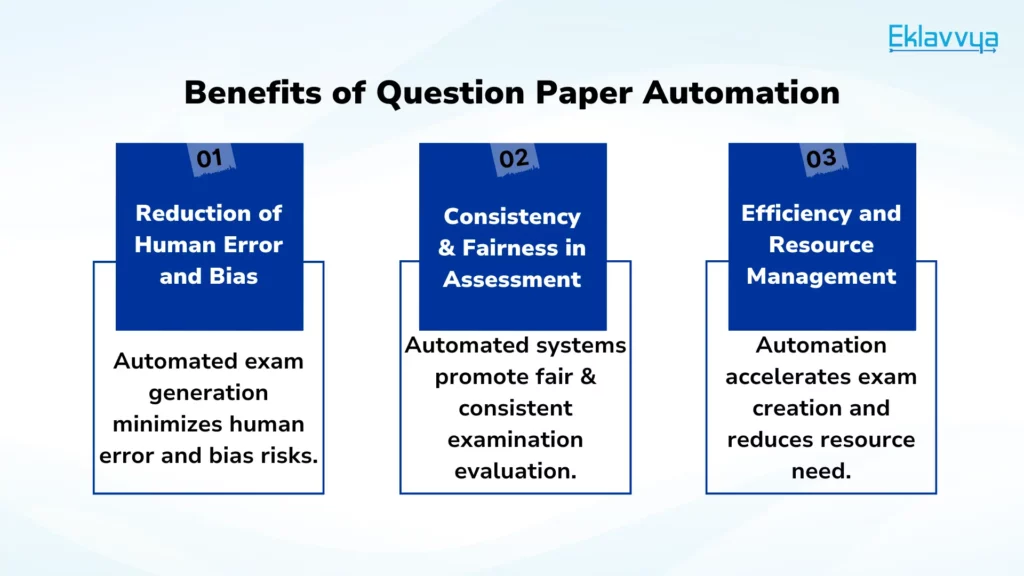
Reduction of Human Error and Bias: Automating the question paper generation process significantly reduces the chances of human error and bias. When exams are created manually, they can unintentionally reflect the biases or preferences of the person creating them, which might not fairly assess the student’s capabilities.
Consistency and Fairness in Assessment: Automated systems ensure a consistent approach to how questions are structured and assessed, which contributes to a fairer examination process. Each student is evaluated on a level playing field, with the same criteria applied uniformly across all exams.
Efficiency and Resource Management: Automation speeds up the process of creating exams, freeing up educators’ time so they can focus more on teaching and less on administrative tasks. It also reduces the need for extensive resources that are traditionally required for exam preparation and delivery.

Enhancing Examination Management with On-Screen Marking Systems
The management of examinations is a complex and critical aspect of educational administration. The adoption of on-screen marking (OSM) systems is transforming how institutions handle this challenge, making the process more efficient, accurate, and insightful.
On-Screen Marking System: An Overview
On-screen marking systems digitize traditional pen-and-paper examinations by scanning written answer sheets and making them available online for evaluators. This technology not only simplifies the logistics of handling physical papers but also enriches the evaluation process with data analytics capabilities.
Data Collection During Examination
Comprehensive Data Points: As evaluators review answer sheets on-screen, the system collects a multitude of data points:
- Time Metrics: The time taken by an evaluator to mark each answer provides insights into the complexity and clarity of questions and can indicate if additional training or resources are needed for evaluators.
- Question and Topic Performance: By analyzing how students perform on specific questions or topics, educators can identify areas where the curriculum may need adjustment or where additional instruction is required.
- Section and Subject Analysis: The system aggregates performance data by sections and subjects, offering a detailed view of academic strengths and weaknesses across different disciplines.
Improving Educational Quality Through Analytics
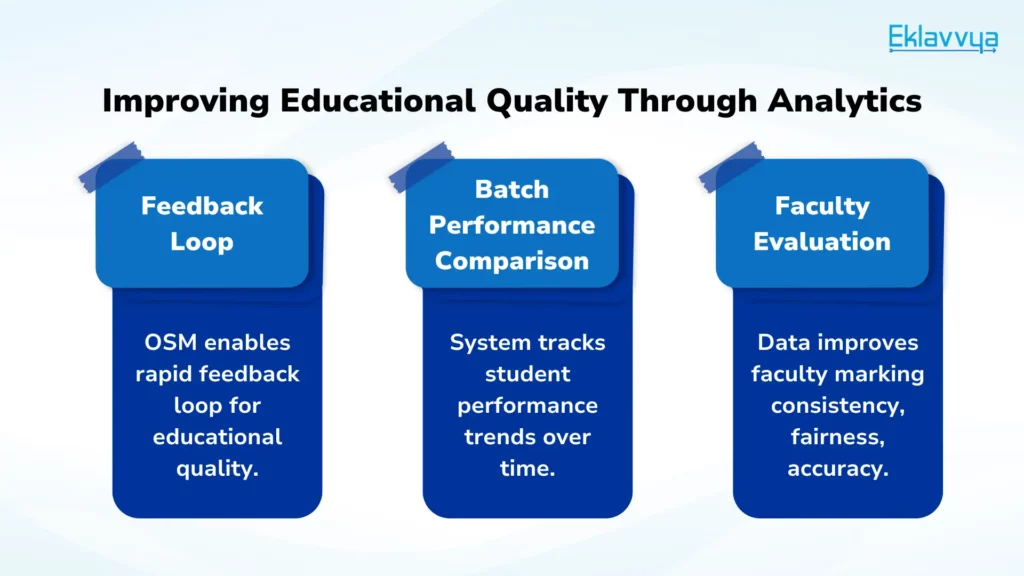
Feedback Loop: One of the most significant benefits of an OSM is its ability to close the feedback loop in educational quality. By providing immediate and detailed insights into student performance, educators can quickly implement changes to teaching methods, materials, and assessment strategies.
Batch Performance Comparison: The system can compare the performance of current batches of students against previous ones, highlighting trends and shifts in educational outcomes. This longitudinal data is invaluable for assessing the impact of curricular changes and teaching interventions over time.
Faculty Evaluation: On-screen marking systems also collect data on how faculty members evaluate student responses. This can be used to assess consistency, fairness, and accuracy in marking, helping to improve the overall quality of assessment.
Support for Accreditation and Compliance
COPO Mapping: On-screen marking systems facilitate the collection of data points needed for Curriculum Outcomes Program Outcomes (COPO) mapping. This is crucial for institutions seeking accreditation from bodies like the NAAC, which require detailed evidence of educational outcomes and processes.
Accreditation Support: The detailed data collected through these systems supports institutions in maintaining compliance with various accreditation standards. By providing precise and accessible data on educational processes and outcomes, OSM systems simplify the accreditation process and ensure institutions meet the required standards.
Strategic Decision-Making Enabled by Technology
Data-Driven Decisions: The rich data provided by on-screen marking systems empowers educational leaders to make informed decisions that directly impact the quality of education offered. From adjusting course content to retraining faculty based on evaluative trends, the insights gained from OSM systems can guide strategic planning and implementation.
Enhanced Administrative Efficiency: By automating the examination process, these systems reduce administrative burdens and allow educators to focus more on teaching and less on logistical complexities.

Conclusion
Educational institutions that embrace data will be better equipped to meet the challenges of modern education. By leveraging data in strategic ways, they can enhance every aspect of the educational experience, preparing students more effectively for the future.
Data can significantly enhance the accuracy of academic certificate validation by automating the verification process. Using technologies like blockchain, institutions can create a tamper-proof digital ledger of issued certificates.
This allows for real-time verification against the original data stored securely on the blockchain, ensuring the certificate’s authenticity and eliminating the possibility of fraud. Additionally, data-driven systems can cross-reference student records across various databases to confirm the validity of certificates and other educational documents.
Data-driven admission processes offer several benefits, including increased efficiency, fairness, and strategic insights. By analyzing historical and current data, institutions can identify trends and patterns that help in predicting applicant behaviours and preferences.
This allows for a more streamlined and targeted admission strategy. Moreover, data analytics can help eliminate biases by ensuring decisions are based on objective criteria rather than subjective judgments, leading to a more diverse and inclusive student body.
Data helps in customizing the curriculum by providing insights into which teaching methods and content are most effective. Through the analysis of student performance data, institutions can identify which topics or modules students find challenging and which they grasp easily.
This information enables educators to adjust the curriculum to better suit the learning needs of their students, such as by incorporating additional resources for topics where students typically underperform, or by advancing faster through areas that students comprehend well.
Yes, data analytics can predict student performance with a high degree of accuracy, especially when comprehensive data sets are used. By analyzing past performance data along with variables such as attendance records, engagement levels in class, and even social and economic backgrounds, predictive models can forecast how well students are likely to perform in future assessments or courses. This allows institutions to provide targeted support and interventions to help students succeed.
When using data, institutions must consider several ethical considerations:
– Privacy: Ensuring that student data is collected, stored, and used in a way that respects their privacy and complies with relevant data protection laws.
– Consent: Obtaining clear consent from students (or parents, if minors) regarding what data is collected and how it will be used.
– Transparency: Being transparent with students about the data collection processes and how the data will influence their education.
– Bias and Fairness: Regularly reviewing algorithms and data practices to prevent and address biases that could affect students based on race, gender, socioeconomic status, or other factors.
Technology can improve the security of examinations by implementing robust measures such as digital proctoring, encryption, and secure authentication processes. Digital proctoring tools can monitor exams to prevent cheating, using AI to detect suspicious behaviours.
Encryption ensures that exam materials and student responses are transmitted and stored securely, preventing unauthorized access. Furthermore, secure authentication processes verify the identity of exam takers, ensuring that only authorized students can access and complete the exams.


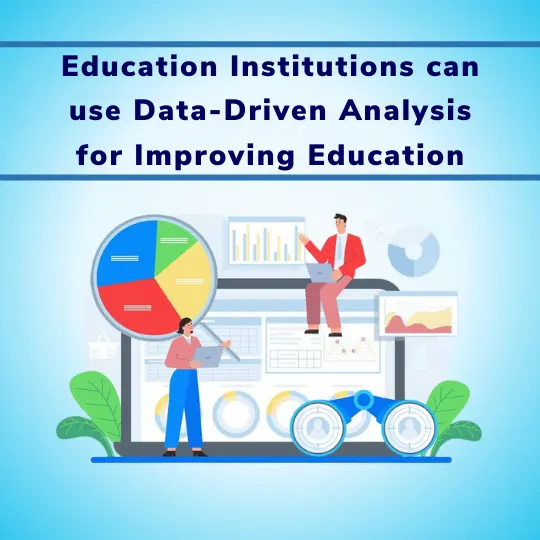

![How Government-Led Exams at 250+ Locations Are Setting New Standards of Integrity [Case Study]](https://www.eklavvya.com/blog/wp-content/uploads/2024/04/Enhancing-Exam-Integrity-Government-Certification-in-250-Locations-150x150.webp)
![Transforming Central Govt. Exams Evaluation: How Onscreen Marking is Leading the Charge [Case Study]](https://www.eklavvya.com/blog/wp-content/uploads/2024/04/How-Onscreen-Marking-Revolutionized-Central-Govt-Exams-Case-Study-1-150x150.webp)



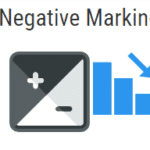









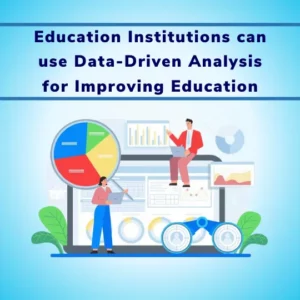

![How Onscreen Marking Revolutionized Central Govt Exams [Case Study]](https://www.eklavvya.com/blog/wp-content/uploads/2024/04/How-Onscreen-Marking-Revolutionized-Central-Govt-Exams-Case-Study-1-300x300.webp)
